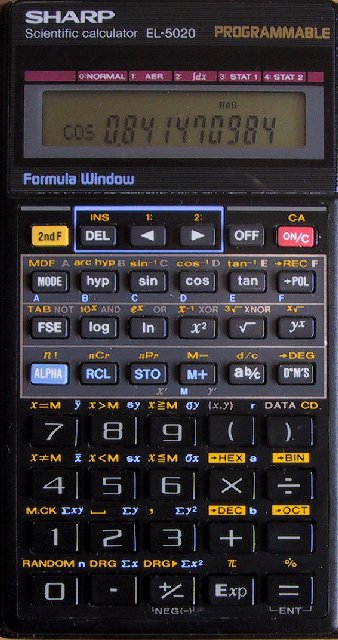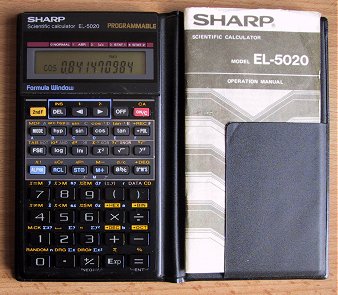sharp el-5020
| here we have a rather nice 10 digit, mixed segment and dot
matrix display, scientific calculator from sharp, 1993. somewhat more modern
than the older, but nice, el-512 styling and
before the later, and more tacky plastic dal style.
as a scientific model, its pretty good with all the usual stuff you would expect including hyperbolics, fractions, number bases, 2d stats with regression, numerical integration and blind formula programmable. the operational style is an interesting mix somewhere between algebraic entry and formula entry. essentially, you calculate using a formula style, but operations can be performed directly on a result (like with aos) by entering an additional = to force evaluation. entering a formula based expression is a bit odd because the machine can only display the last part of the entry in the small dot matrix portion on the left of the display eg. press sin cos tan 1 = to compute sin(cos(tan(1))). the right arrow key can be pressed to delete digits of number entry, but do not delete operations of a pending formula when not programming. 12 digits are used internally and, when not in number bases, the letters A-F and M (the main memory) can be used to store values and indeed can be used as variables in the formula aer mode. algebraic expression reserve (aer) modethis is, in fact, the programmable mode of the machine. there are two areas 1: and 2: that can store a total of 40 steps. the formulae can involve variables A-F and M (these are the only alpha characters available, despite an alpha key). statements can be appended with comma. for example, A+1=>A,3A^2+7A+9 is valid. a limited set of branch conditions are allowed (now quite normal for blind program formulae). these are; x=m,x!=m,x<m, x>m, x<=m, x>=m the condition always causes a branch to the start of the program. program editing is possible with the arrow keys, del and ins. numerical integrationlike a lot of modern formula programmables, here is numerical integration implemented by unmodified simpson's rule. as usual, the integration limits are evaluated and must exist. furthermore, the number of subdivisions must be supplied, directly and not as a power of 2. there is no error tracking and no indication of how much of the numerical result is correct. nevertheless, this is useful albeit a bit slow (see torture test).
|
 |
| the unit lives in a folding wallet style cover, typical of scientific models. it is powered by 2 lr44 cells (g13) and boasts 1300 hours of continuous use. |  |